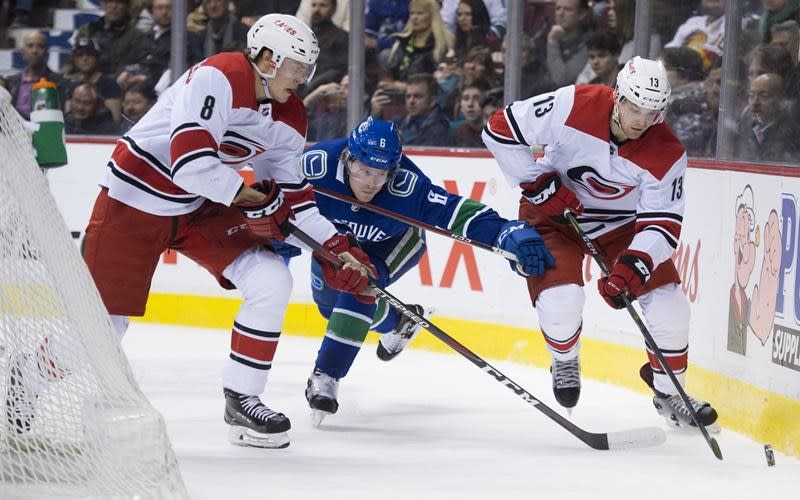Why do so many dead-end teams ‘go for it?’
Something which has long confounded me about the NHL is why so many teams are willing to put themselves in the playoff conversation (often through media proxies, but not always) if they’re five or six points out of the playoffs at the start of February.
On some level, it’s easy to say it’s because so many coaches’ and even GMs’ jobs are on the line if their teams fail to make the playoffs, and that certainly seems like it plays into it. Players, too, want to be able to do well down the stretch so that they can obtain performance bonuses or get a better AAV or more term on their next contract.
But another thing you hear sometimes is just how much it means to teams and fanbases to have meaningful hockey down the stretch, with the promise of at least two games’ worth of playoff revenues as an added bonus. And that’s the thing I think is really at the heart of it.
Because unlike, say, the NBA where tanking is de rigueur and seen as a good and smart strategy for improving, making the playoffs matters a lot to teams on the fringes. There’s a simple reason for this: The NHL is a league that relies almost entirely on gate revenues, whereas the “major” North American sports do not.

The NHL claimed a projected $4.54 billion in revenues last year, which is no small number on its own. But the NBA, which has one fewer team and plays the same number of games in many of the same buildings (though with lots more space for seating on the floor) got $7.4 billion in revenues over the same season. Never mind MLB ($10.3 billion) and NFL (potentially as much as $25 billion).
This is due in large part to the fact that all those leagues have much better TV deals than the NHL’s, which is only worth $200 million a year and runs through 2021 in the U.S., and about $327 million and falling in Canada, running through 2025. The Sportsnet deal isn’t great because it’s based on the value of the Canadian dollar, which has dropped sharply since the deal was signed in 2013. At that time, it’s expected the bidding for NHL rights will be a little more contentious, and revenues should rise a bit due to the Seattle expansion team getting going around the time the U.S. deal expires.
But until such time, NHL teams are still really, really, really hoping the fans will show up in February, March, and April. And that they’ll barely squeak into the playoffs so they can get a few million more dollars in gate and concession revenues out of the deal.
The problem for NHL teams is that by continuing to use the Jay Feaster-created term of “Going For It” when they’re barely clinging to hopes of getting the eight seed and probably getting clobbered is that it keeps them in a near-permanent state of being one of the teams that need to do that. How many clubs have fought like hell to be eighth in the East only to fall short, pick 13th overall, and never really get much better over the space of four or five years?
This is why you’re increasingly hearing talks about teams like Columbus or Carolina considering guys like Micheal Ferland and Artemi Panarin as “own rentals,” just to cite to examples I’ve seen in the last few days. It becomes a question of how teams value these kinds of players versus the potential return they’d get from a trading partner, then.
With Columbus, for instance, the decision in part comes down to, “If we keep Panarin, he’s probably worth x home playoff games, which translates to y dollars in revenues, but if we trade him, we are in grave danger of missing the playoffs and fans might stop showing up in the regular season too.” That must be weighed against how they value the, say, first-round pick, high-end prospect, and B-level prospect they’re reportedly seeking for Panarin, in future terms of dollars and cents?
This is all hypothetical, of course, but it’s a dollars-and-cents decision many teams around this league have to make at this time of year, and whether they actually think they’re playoff-competitive is almost immaterial. To keep gate revenues going strong over the remainder of the regular season, some teams have to create the illusion that they think overcoming a four- or five-point deficit and leapfrogging two other teams to do it is doable.
Which is mostly fine if you don’t have a big name to sell and don’t think you’re bad enough to end up with a top-five pick. But if you’re holding onto top assets that could get you something nice on the trade market because you want the revenues instead, that seems like dereliction of duties.
But let’s be honest: If you’re not in the top five in your conference or have a compelling reason to think you can overcome a lower seed (i.e. getting in with a bad PDO but great underlyings, like the 2012 Kings, rather than just saying, “Well anyone has a chance!”), then you’re better off in the long run trying to get as many top-15 draft picks as possible. That is, if you’re serious about putting winning ahead of all other considerations.
NHL teams often don’t see it that way, often because that doesn’t make the right kind of financial sense.
More NHL coverage from Yahoo Sports
Ryan Lambert is a Yahoo! Sports hockey columnist. His email is here and his Twitter is here.
All stats via Corsica unless otherwise noted.


